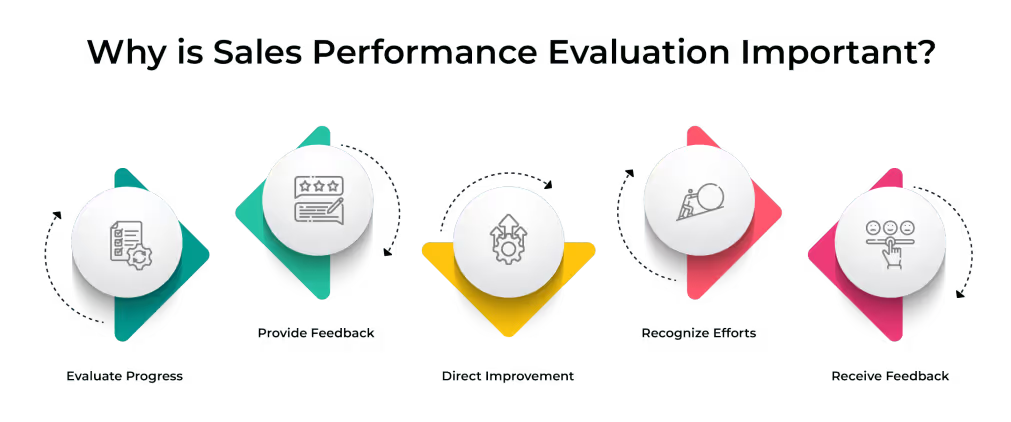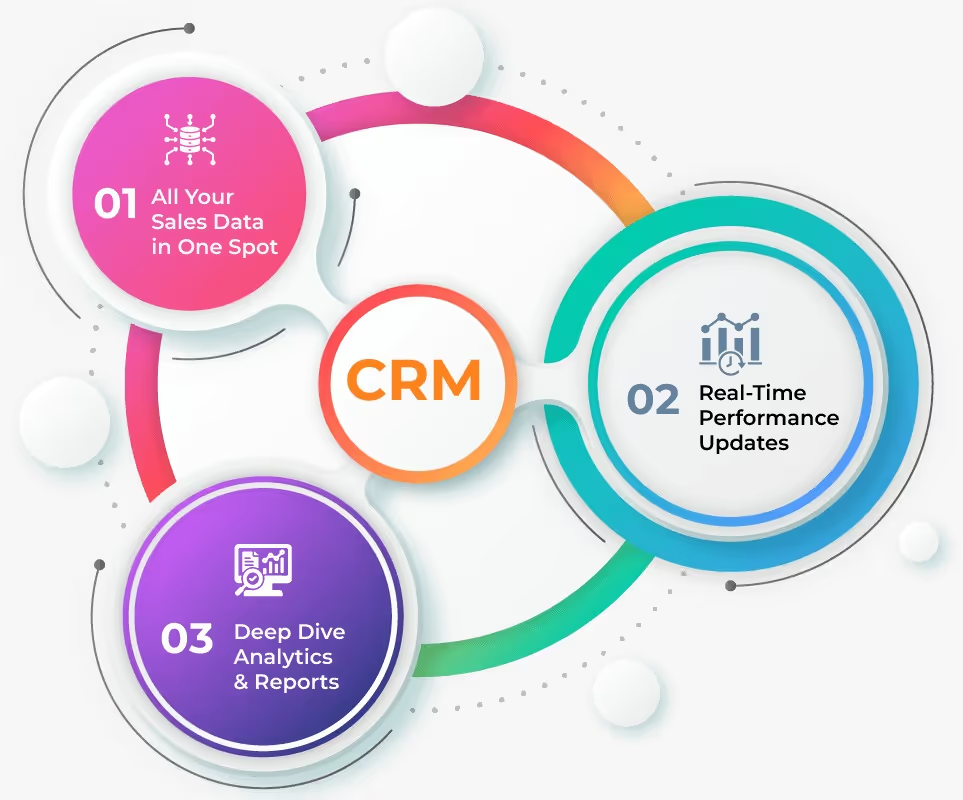
Blog
What Is Sales Performance Evaluation and Why It Matters?
November 3, 2023


Key Insights
How influential is your salesforce in growing the organization?
Salesforce is THE decisive factor in driving business, revenue, and growth. Realizing the impact of their work in enhancing business performance, companies spend over one trillion dollars annually on sales forces.
If such a large sum of money is spent on their growth, progress, and enhancement, surely an evaluation is mandatory.
In this article we will explore sales performance evaluation, trying to understand its importance, and steps to follow while building a sales performance evaluation template.
Scroll down for more.
What is a sales performance evaluation?
Sales performance evaluation refers to the annual meeting between a sales manager and their sales representative where they discuss their work, performance, responsibilities, challenges, progress made, plans for future development, contributions to the organization, and conduct sales performance analysis, among other topics.
Based on this evaluation, the manager decides on the promotion, appraisal, and other growth possibilities of sales associate vs sales executive.
Why is sales performance evaluation important?
Evaluating how well your team has performed and understanding your performance and progress are crucial approaches of sales planning for the growth of the organization and the employee
Let's look in detail at the other benefits it offers:

Evaluate Progress
Sales performance evaluation helps track the progress made by the salesforce. The number of sales they closed, the quota they achieved, the revenue generated, and the impact of sales performance incentive programs (SPIFs) help managers understand the effort put in by the employee in bringing growth to the organization.
Provide Feedback
For progress to happen feedback is important. Managers must evaluate their team’s strengths and weaknesses and suggest areas of improvement. These insights on one’s performance and guidance to the opportunities available will help salesforce understand their current position and motivate them to upskill for better performance.
Direct Improvements
No one is good at everything. While beginning their career, people need guidance and direction or a sales strategy roadmap to help them improve. Sales managers while evaluating sales performance must show areas that the salesperson can improve and schedule sales coaching sessions to ensure consistent growth.
Recognize Efforts
The greatest motivation that any employee expects from their organization is not money and other rewards. But recognition of one's efforts and appreciation. When they understand that their organization knows and acknowledges their efforts it will drive them to work harder to improve their performance and retain their reputation as a hardworking professional.
Receive Feedback
Sales performance evaluation is not a one-way transaction where employees are evaluated for their sales performance and productivity. It is also a platform where organizations can receive feedback on where the team feels they can improve, contributing to sales performance optimization. These insights will help companies to better their work culture and performance.

Evaluation is a positive way to grow for both the employees and the organization. However, it will be effective only if companies take a constructive approach to the analysis.
So how should companies go about with sales performance evaluation? Let's scroll down.
What are the steps in the evaluation of sales performance?
For further reading check Innovative Sales Performance Management Solution.
Here is a step-by-step guide for sales performance evaluation
A disadvantage of sales is that it expects a lot while forgetting to give positive affirmations and constructive feedback. Organizations must be clear on sales performance evaluation, expected outcomes, and ways to achieve it.

Determine the metrics for evaluation
Clarity on how the salesforce is evaluated is the foundation for a good sales performance evaluation. The number of sales closed, on-target earnings, sales quota achievement, number of leads in the pipeline, their progress, and the insights provided by sales performance reporting are metrics that managers can use to evaluate their salesforce performance.
Follow the sandwich model of feedback
Learning how to give feedback is a skill that managers must imbibe. The ideal way is the sandwich model of giving feedback. Here the manager appreciates the achievements and strengths of the salesperson, then they move to the areas that the salesforce must focus on for improvement and finally wrap it up with a good note that with all these strengths they can easily overcome their weakness. It helps the salesforce feel good about their accomplishments and motivated to improve their performance.
Ensure to provide areas of improvement
Evaluation must not just point at the salesforce weaknesses and drawbacks. While showing them where they lag, managers must also guide them to overcome these challenges by providing areas of improvement and how to go about with them. Taking up coursework for knowledge gain, upskilling to meet the requirements of a sales job, etc., are ways managers can ensure their salesforce improves in performance. Implementing a sales lift calculator can further enhance this process by quantifying performance improvements and helping sales teams set realistic goals for continuous enhancement.
Provide feedback backed by data
With sales performance management tools, it's easy for managers to keep track of their salesforce performance, converting everything into data that shows where the salesperson stands in their performance, their strengths, and weaknesses. Providing these valuable insights while directing salesforce on how to improve will help them have better visibility and understanding of their performance and thereby motivate them to improve. Integrating feedback sessions during regular sales meetings can enhance communication and collaboration within the sales team.
Set goals to focus
Expecting employees to improve without communicating the company objectives and setting personal goals is futile. Setting goals to focus on must be a crucial part of the sales performance evaluation process. Each time, it must be a step higher than last year's goals. Creating this sales performance template helps salesforce to focus their efforts and strategies towards fulfilling their goals.
Ask for their remarks
Every sales performance evaluation must conclude by asking the salesforce for their feedback and remarks about the organization and its operations. An employee who is a part of the system will have a better understanding of the shortcomings of the operations and suggest ways to enhance your work culture.
Organizations must build a framework and organize methods of evaluating sales performance to ensure consistent growth of their team and the organization.
For further reading, check Unlocking Success: Crafting a Winning Sales Performance Improvement Plan.
Sales Performance Evaluation Examples
Feeling lost about how to do performance reviews? This is your lucky day! These examples are a roadmap, complete with numbers to make things clear.
No more guessing what works well and what needs improvement for your sales reps.
1. Revenue-Based Evaluation
Metric: Total sales revenue Example:
- High Performer: A salesperson who consistently exceeds their sales targets by 20% each quarter, contributing significantly to the company's overall revenue growth.
- Improvement Needed: A salesperson who only achieves 60% of their quarterly sales target, indicating a need for additional training or support.
2. Quota Achievement
Metric: Percentage of sales quota achieved Example:
- High Performer: An employee who achieves 110% of their annual sales quota, demonstrating strong sales skills and effective customer engagement.
- Improvement Needed: An employee who achieves only 70% of their sales quota, suggesting they may need to refine their sales techniques or prospecting strategies.
3. Sales Growth
Metric: Year-over-year sales growth Example:
- High Performer: A salesperson who increases their sales by 30% year-over-year, showing consistent improvement and market penetration.
- Improvement Needed: A salesperson whose sales remain flat or decline year-over-year, indicating potential issues with their sales approach or market conditions.
4. Customer Acquisition
Metric: Number of new customers acquired Example:
- High Performer: A salesperson who brings in 15 new customers in a quarter, demonstrating strong prospecting and closing skills.
- Improvement Needed: A salesperson who acquires only 5 new customers in the same period, highlighting a need for better lead generation or closing techniques.
5. Customer Retention
Metric: Customer retention rate Example:
- High Performer: An employee who maintains a 95% customer retention rate, indicating excellent customer relationship management.
- Improvement Needed: An employee with a 70% customer retention rate, suggesting they may need to focus more on post-sale service and support.
6. Deal Size
Metric: Average deal size Example:
- High Performer: A salesperson who consistently closes deals with an average size of $50,000, showing an ability to upsell and add value.
- Improvement Needed: A salesperson whose average deal size is $20,000, which might indicate missed opportunities to upsell or cross-sell.
7. Sales Cycle Length
Metric: Average time to close a sale Example:
- High Performer: A salesperson who reduces the sales cycle from 6 months to 4 months, showing efficiency in moving prospects through the sales funnel.
- Improvement Needed: A salesperson with an average sales cycle of 8 months, suggesting a need for more effective sales tactics or follow-up processes.
8. Conversion Rate
Metric: Lead-to-customer conversion rate Example:
- High Performer: An employee who converts 30% of their leads into customers, indicating strong qualification and closing skills.
- Improvement Needed: An employee with a conversion rate of 10%, pointing to potential issues in lead qualification or the sales pitch.
9. Sales Activity
Metric: Number of sales calls, meetings, or demos Example:
- High Performer: A salesperson who conducts 50 sales calls and 20 product demos per month, showing proactive engagement with prospects.
- Improvement Needed: A salesperson who only makes 20 sales calls and 5 demos, suggesting they may need to increase their activity levels to boost performance.
10. Profitability
Metric: Profit margin on sales Example:
- High Performer: A salesperson who consistently achieves a profit margin of 25% on their deals, indicating effective negotiation and value selling.
- Improvement Needed: A salesperson with a profit margin of 15%, which might suggest they need to improve their negotiation skills or focus on higher-margin products.
Giving constructive, actionable feedback is a crucial way to support your sales reps. Here's how to do it right.
Feedback is like a GPS for your sales reps. Without it, they’re navigating the tricky landscape of sales performance without a map. But, giving feedback that truly helps can be tricky. Here’s how to do it right and keep your team motivated and on track.
1. Be Specific, Not General
Instead of saying, “You need to improve your sales pitch,” try, “When you’re pitching, focus on highlighting the product’s unique features in the first two minutes. It will grab their attention better.
2. Balance the Good with the Not-So-Good
Start with something positive—maybe praise their enthusiasm or their rapport with clients. Then, dive into the area where they need improvement. Finish with another positive note or encouragement. This approach not only makes the feedback easier to digest but also keeps the conversation balanced and motivating.
3. Make It Actionable
Feedback without a clear path forward is like giving someone a puzzle without the pieces. Instead of just pointing out what went wrong, provide specific actions they can take to improve.
4. Encourage Two-Way Communication
Feedback should be a dialogue, not a monologue. Encourage your sales reps to share their thoughts and perspectives. Ask questions like, “What challenges are you facing with your current strategy?” This not only helps you understand their viewpoint but also fosters a sense of collaboration and trust.
5. Follow Up and Offer Support
Don’t just deliver feedback and walk away. Check-in regularly to see how they’re applying your suggestions. Offer additional resources or training if needed. For instance, if a rep is struggling with closing techniques, suggest a workshop or role-playing exercises. It shows that you’re invested in their growth and success.
How CRMs Can Make Sales Evaluations a Breeze
Alright, let’s get into how CRMs can be your new best friend when it comes to evaluating your sales team.
Imagine you’re trying to keep track of everyone’s performance, and it feels like you’re juggling a million things at once. That’s where a CRM (Customer Relationship Management) system swoops in to save the day. Here’s how it makes your job easier and your evaluations more effective:

1. All Your Sales Data in One Spot
Think of a CRM as a high-tech filing cabinet that keeps all your sales data neatly organized. No more digging through endless spreadsheets or searching for that one email.
With a CRM, you can see everything you need in one place. Want to check how many deals a rep has closed this month? It’s right there. Need a quick overview of team performance? Just a few clicks, and you’ve got it.
2. Real-Time Performance Updates
Imagine having a live scoreboard that updates in real time. That’s what a CRM gives you. You can instantly see how your team is performing, which reps are smashing their targets, and who might need a little extra help. If a sales rep is knocking it out of the park, you’ll know right away.
If another is falling behind, you can catch it early and provide support before things get out of hand.
3. Deep Dive Analytics and Reports
They churn out detailed reports and analytics that show you exactly what’s working and what’s not. Curious about which sales tactics are hitting the mark? Your CRM can show you. Wondering if a new training program is paying off? The CRM’s got those insights too. It helps you see the bigger picture and make smart decisions based on solid data.
CRMs aren’t just fancy tools, they’re game-changers for managing and evaluating your sales team. They streamline your data, keep you updated in real-time, and help you support your team effectively.
Conclusions
Various factors go into consideration while determining the performance and productivity of an employee.
Their efforts as an individual in the team and their initiatives to enhance the team's performance are factors that are decisive in determining their contribution to the growth of the organization and enhancing its work culture.
Salesforce must always have improvement strategies to enhance their product knowledge and sales approach to ensure they are better in their game than the previous year. This consistent growth will help them achieve their personal goals and company objectives as well as make a mark in the organization.
Sales performance evaluation needs a sales performance management tool that will provide valuable insights to the management and the employee on the progress made and needed.
Kennect provides an intelligent sales performance management tool for a data-informed approach to planning, managing, and analyzing sales performance. For more information, Book A Demo Now!
ReKennect : Stay ahead of the curve!
Subscribe to our bi-weekly newsletter packed with latest trends and insights on incentives.
Thank you! Your submission has been received!
Oops! Something went wrong while submitting the form.
Your data is in safe hands. Check out our Privacy policy for more info






.avif)








